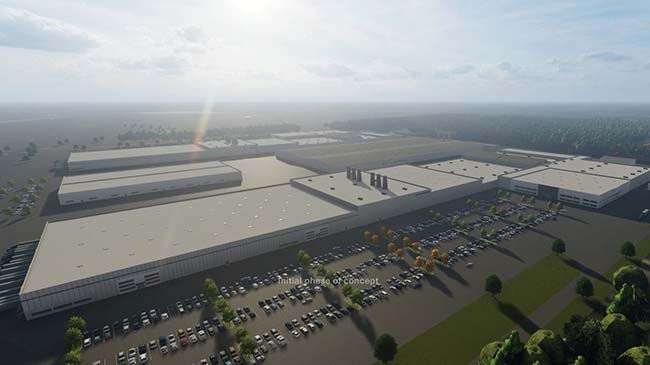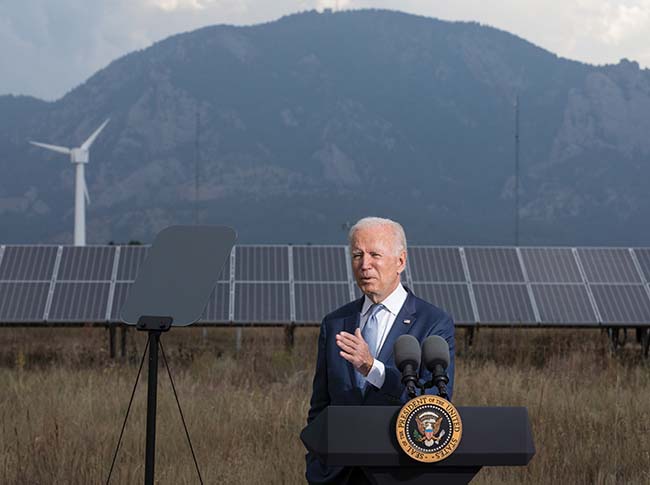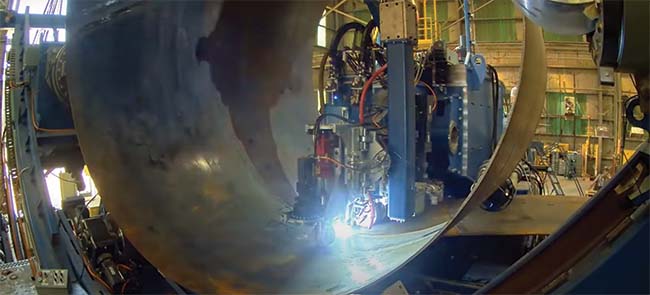Power Sector Seeks Solutions for Supply Chain Issues

The pandemic exposed issues with the global supply chain that provides resources for power generation. The pressure of having enough equipment to meet industry needs has spurred an emphasis on domestic manufacturing in the U.S. and elsewhere.
Power generators have faced challenges the past few years when it comes to sourcing equipment, and in some cases workers. The fallout from the coronavirus pandemic, notably issues with supply chains, still ripples across the industry.
Some of the logistical problems may be starting to ease. Backlogs of equipment, stuck at shipping ports worldwide and certainly in the U.S. due to labor shortages and other factors, have been moving in recent months. There's been a wave of company announcements regarding domestic manufacturing, reducing the need to import equipment and providing support for future deployments of power generation facilities.
The COVID-19 pandemic was a wakeup call in many ways," said Anders Sjoelin, president and CEO of S&C Electric Co. When the factories, flights, people, and systems that power our global supply chain and economy stopped, our dependency on this logistical ecosystem became a vulnerability. Interruptions to this global value chain of raw-material suppliers, component makers, and manufacturers still reverberate today, disrupting everything from home-improvement projects to critical infrastructure buildout."
Sjoelin told POWER, Everyone expected demand to drop as the scope of the pandemic became clear. But demand kept up, and in some cases, increased. This created an imbalance. Now, of course, the hope is that expectation and demand will be more in with each other."
The pandemic brought increased demand for a variety of goods that would have been hard to meet under ordinary conditions, but the additional labor and supply chain challenges made it even harder to meet that demand," said Paul Marushka, CEO and president of Sphera, a provider of environmental, social, and governance performance and risk management software, data, and consulting services. Marushka told POWER, Consumer demand continued to rise once COVID-related restrictions eased, although for different types of products. This demand has put pressure on already strained supply chains that have not yet fully recovered from the pandemic."
A.P. Moeller-Maersk is among the world's biggest shipping companies and controls about one-sixth of the global container shipping industry. The group in a recent earnings report said there has been an easing of supply chain congestion," though there remain plenty of dark clouds on the horizon" that will impact global transportation and logistics demand."
Sourcing Raw MaterialsThe battery energy storage industry in particular has paid close attention to issues with its supply of raw materials. A lack of those materials means the sector can't meet demand on many fronts, including to serve the market for electric vehicles (EVs). A 2022 study by E Source, a group that provides research for utilities, said the cost of EVs will continue to rise over the next few years in part due to a scarcity of raw materials for both batteries and other parts of these vehicles.
The automotive market apart from EVs already has been challenged by the shortage of semiconductor chips that stalled new vehicle production, and also delayed the launch of many consumer electronics. Said Sjoelin, Obviously, we are still catching up with semiconductor chips, as these have longer lead times. The pandemic showed us that it takes very little time to shut down capacity, but starting it back up again takes much longer. That's where we are right now."
The shortage of semiconductors was partly addressed by the Biden administration with the signing of the CHIPS and Science Act in August of last year, a measure that provides some $280 billion in funding to boost U.S.-based research and manufacturing of semiconductors. The Semiconductor Industry Association last summer noted that the U.S. share of global modern semiconductor manufacturing capacity had fallen from 37% in 1990 to 12%.
There are some materials apparently not in short supply. Josef Daniel-Ivad, manager of the Zinc Battery Initiative, told POWER: While supply chain concerns abound for many critical minerals, zinc is naturally plentiful, with 247 million metric tons proven reserves of zinc, and an estimated 63,000 million metric tons of zinc available in the future from extractable global resources. In addition, the zinc supply can be sourced globally, with strong supply chains in North America, Europe, and Asia."
Daniel-Ivad added, Another benefit is the recyclability of zinc, with 34% of zinc being recycled in 2019, and the recycling rate for zinc continues to increase annually as companies work towards their sustainability targets. Thanks to a robust recycling flow and an abundant supply, zinc batteries and zinc used to protect renewable wind and solar power installation will be in strong supply."
More domestic production of energy storage equipment is on the horizon. KORE Power, an Idaho-based manufacturer of high-energy-density lithium-ion pouch cells and module configurations, recently announced construction of a gigafactory" in Arizona, helped with funding from Siemens Financial Services and utility contractor Quanta Services. Other investors in the project include Nidec Motor, Honeywell Ventures, and Trog Hawley Capital. The first output from the factory is expected in 2024, with production of as much as 12 GWh of lithium-ion battery cells to support energy storage and e-mobility.
Pandemic-and More-Stresses the SystemThe pandemic showed we had holes in the supply chain and caused the initial problem, but there are still issues outside of COVID, according to Pete Aden, a partner with Wipfli who focuses on construction and real estate. Wipfli provides data analysis and industry-specific solutions to a variety of sectors, including power generation. Aden told POWER, We've gone to just in time,' and there is no wiggle room. When you have a hiccup in the system, from weather to workforce, the issues become exacerbated."
The more efficient and reliable supply chains are, the better everything runs," said Marushka. Supply chain issues impact all sectors, including energy. They create problems for energy suppliers who can't get the equipment and parts needed to maintain operations. With respect to renewable energy, these problems delay the construction of renewable energy projects."
 |
1. The solar power industry has struggled with equipment shortages in the past couple of years. To help kickstart the clean energy industry in the U.S., President Biden authorized use of the Defense Production Act to accelerate domestic production of solar panel parts, among other things. Source: Werner Slocum / National Renewable Energy Laboratory |
Solar power companies decried tariffs and outright bans on imported materials, which delayed project timelines in the U.S., Europe, and elsewhere. Some of those issues have been resolved, but they also provided an impetus for more domestic manufacturing of solar power components, at least in the U.S. (Figure 1).
First Solar, the largest U.S.-based solar panel manufacturer, in November said it would invest about $1.1 billion in a new manufacturing facility in Alabama. The company said the Alabama plant, its fourth U.S.-based factory, would produce 3.5 GW of solar modules annually by 2025. Mark Widmar, the company's CEO, said the Inflation Reduction Act and its incentives for domestic manufacturing of energy equipment, provided the impetus for the new plant.
The passage of the Inflation Reduction Act of 2022 has firmly placed America on the path to a sustainable energy future," Widmar said in a statement announcing the Alabama plant. This facility, along with its sister factories in Ohio, will form part of the industrial foundation that helps ensure this [energy] transition is powered by American innovation and ingenuity."
Other solar companies, such as SolarEdge and Enphase Energy, also have said they are exploring U.S.-based manufacturing after passage of the climate bill.
Reed Sellers, another partner at Wipfli, told POWER, Manufacturers have had the time to readjust their production, so while maybe COVID was the first domino in this disruption, we have moved on to new issues such as trade embargos/tariffs, port management, pricing, trucker shortages, pricing of diesel, and so on."
Specific to solar, Sellers said, We saw large issues with solar modules as many were manufactured overseas. There were limited suppliers, and they would sell to those who needed the highest number or would get the best price. So, the smaller buyers couldn't get the supply they wanted. Tariffs were at least temporarily suspended, which seemed like it would free up the supply, but new issues quickly popped up due to the Uyghur Forced Labor Prevention Act, or UFLPA [which concerns how the U.S. deals with China]. Quite simply, demand still outweighs supply."
Said Sellers, So, now we start talking about moving manufacturing capabilities domestically. But that doesn't happen overnight. There are tax credits for solar that help incentivize [projects]. Buyers, therefore, increase demand. But those incentives are temporary and subject to change with each new administration. This puts manufacturers looking to make investments in new domestic manufacturing facilities in a bit of a tough spot. Will the demand still be there by the time facilities are up and running?"
Workforce ChallengesSellers said more domestic manufacturing also brings other challenges. The labor force is still an underlying issue. If there is more domestic manufacturing, where does the labor force to run these factories come from? What we need to focus on is smart manufacturing and automation." Said Wipfli's Aden, We'd also love to push the concept of trade/technical schools and making electricians a cool career."
The calls for workforce training are many as the energy industry evolves. Sean Silvey, a product application specialist at Fluke, a company that manufactures electrical test and measurement tools, told POWER: The Inflation Reduction Act further turbocharges renewable energy deployments fostering an influx of new solar technicians to a booming green workforce in 2023. These new technicians, regardless of previous industry, may find the instruments and processes they need to familiarize themselves with are more complex than expected. To prevent delays in solar project installations, there will be a sharp increase in demand for solar installation training, easy-to-use tools, and access to trusted resources in 2023."
 |
2. Battery manufacturing company FREYR recently announced the selection and purchase of a site in Coweta County, Georgia, for its planned Giga America battery plant. This image is the initial phase of concept rendering for the facility. Courtesy: FREYR |
The power generation workforce almost assuredly will need to expand, both for manufacturing and project deployment. Along with solar (and wind), the energy storage market wants more U.S.-based manufacturing as well. Battery maker FREYR in November announced it would build a $1.7 billion Giga America battery manufacturing facility (Figure 2) at an industrial park in Coweta County, Georgia. Executives with Piedmont Lithium, a lithium miner, in November said the company wants to build a mining and processing operation on 1,500 acres in North Carolina, about 30 miles west of Charlotte.
Tom Einar Jensen, co-founder and CEO of Norway-based FREYR, said the factory underscores FREYR's ambition to develop a very strong and near-term operational footprint in the United States. Expanding into the U.S. has been a foundational aspect of FREYR's long-term strategy from our inception, and with the recent passage of the Inflation Reduction Act, we expect U.S. demand for ESS [energy storage systems], passenger EV and other electric mobility applications to grow rapidly over the next decade."
Daniel-Ivad noted the strong supply of zinc, and others in the energy sector said supplies of cobalt sulfate and nickel sulfate also have improved, which should further help the battery storage industry. The U.S. government in November said it would provide support for a nickel and cobalt processing facility in the Philippines that would launch the Critical Mineral Supply Chains initiative, a program designed to expand the production of refined nickel and cobalt in the Philippines by 20,000 metric tons per year.
Wind Turbine ManufacturingThe U.S. Department of Energy (DOE) in a recent report pointed to two companies addressing supply chain challenges in the wind power sector by developing innovative manufacturing techniques, with funding support from the agency. Keystone Tower Systems, a group founded by researchers from the Massachusetts Institute of Technology, is using a spiral-welding technique (Figure 3) in order to minimize the need for expensive steel. GE Renewable Energy has been using 3D printing to create customizable tower bases, enabling GE to 3D print the bottom portion of the wind turbine towers on-site at wind farms, which lowers transportation costs.
 |
3. Keystone Tower Systems uses a spiral-welding technique to minimize the need for steel in its equipment that serves the wind power market. Source: Keystone Tower Systems / YouTube |
The DOE also has worked to improve the fabrication process for turbine blades with a partnership among the agency, Sandia National Laboratories, TPI Composites, and Iowa State University. The groups have established advanced techniques that reduce the time it takes to produce a single blade, saving both time and money.
Wind power equipment makers are also taking steps to improve the manufacturing process. Vestas recently signed an agreement with LM Wind Power, a maker of wind turbine blades, to support the wind energy supply chain. The agreement includes design and manufacturing of blades for V172-7.2-MW wind turbines of Vestas' EnVentus platform.
This new partnership highlights how we are increasingly collaborating with partners in a flexible setup to scale efficiently and build on the foundations we have established across our global supply chain," said Tommy Rahbek Nielsen, executive vice president and chief operating officer of Vestas. We aim to leverage LM Wind Power's proven and extensive engineering and manufacturing capabilities coupled with their global footprint to support our customers with high-quality sustainable energy solutions meeting all Vestas standards."
The groups said LM Wind Power will work with Vestas during blade development to optimize blade design, manufacturing setup, and global supply. The recent agreement is a continuation of the existing Vestas and LM Wind Power partnership to manufacture V150 blades in Brazil announced earlier in 2022.
Legislative SupportSjoelin noted the importance of government initiatives to solve supply chain problems. What I can tell you is this: With newly focused attention on supply-chain availability and resilience, U.S. manufacturing is at an inflection point," he said. The recently passed infrastructure bill and CHIPS Act enable direct investment of billions of dollars into the manufacturing sector responsible for critical components, again, to improve capacity and supply certainty."
Sjoelin said the legislation will help drive the onshoring of U.S. manufacturing. Localizing the supply chain will go a long way towards reducing supply chain hiccups. Additionally, government could also make sure that the rules and regulations support long-term planning and investment decisions, so that we don't get caught up in the imbalance of supply and demand again."
He continued: In the U.S., manufacturing has long been the foundation of the country. With continued investment and collaboration to build the manufacturing industry and help us become more resilient, innovative, and sustainable, we can address pervasive supply-chain issues, provide environmental stewardship and leadership through the energy transition, and provide jobs that unlock career and economic opportunities for more people."
-Darrell Proctor is a senior associate editor for POWER (@POWERmagazine).
The post Power Sector Seeks Solutions for Supply Chain Issues appeared first on POWER Magazine.